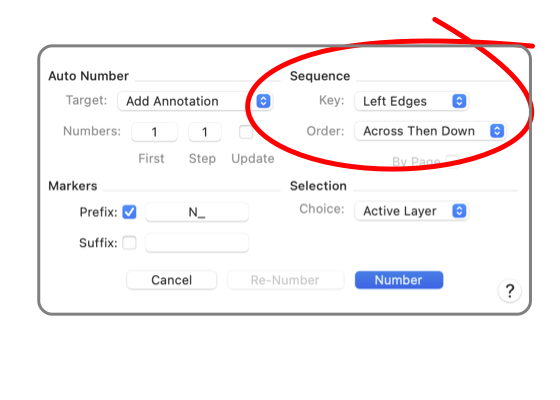These parameters control ordering of the graphics for their assigned sequence integer. The Key parameter specifies the point on each graphic that will be used to define its position relative to the other graphics selected for the sequence. The Page checkbox allows the rules specified to be applied on a per-page basis or across the whole drawing.
The Key menu interacts closely the choice for Order. If items on this menu are disabled it is due to the logic specified by the value of the Order parameter.
|
The Key parameter is used to select a unique position on each graphic for relative location testing in the ordering process. The most common choice might be Centers, or Left Edges. The point specified applies to the bounding box for the graphic. In the case "Centers", the logical center is used (for an Arc the center of the Arc is the equidistant point used to scribe the arc).
The Order parameter is used in conjunction with the relative key locations to determine which Number is assigned to each graphic. The primary choices are "Across" or "Down". If Across is used the graphics are numbered simply from left to right according to their key location. Down will cause the numbering to be strictly on the top to bottom locations. Across-Then-Down is needed when the numbering is to be across, row by row or line by line. Down-Then-Across applies to numbering down a column of elements then continuing the numbering at the top of the next (to the right) column.
Painting Order
provides a way to overtly direct the exact numbering sequence using the graphics drawing index rather than drawing location.
The By Page check box can be used to apply the sequencing logic on a page by page basis. The precise location of the Key Point is used to determine the page associated with each graphic. Across First or Down First page numbering is set on the
Page Layout
palette.
|
The Across-Then-Down and Down-Then-Across operations apply a very "loose" comparison of actual row or column. The comparisons are locally relative between two graphics, and independent of absolute position on the drawing. If two graphics have any overlap of boundaries in the primary direction, they are determined to be in "a" row (or column). If two graphics are determined to be in the same row or column, then their relative spot in the sequence is determined by the "other" direction. In most cases this will provide the intended results. If elements are staggered or more random in position the logic may not develop the desired patterns that might seem so obvious to the human eye. In these cases it may be quicker to guide the process using particular selected graphics rather than attempting to find a logic and positioning combination that works.




